|
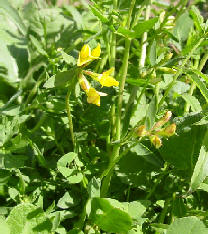 Birdsfoot Trefoil Birdsfoot Trefoil
Family Fabaceae (common Pea)
Lotus corniculatus
Birdsfoot
trefoil is a short-lived ground-hugging perennial that was
introduced to stabilize soil on stream banks. It has clover-like
compound leaves with 5 leaflets, 5-20 mm long. There is 3-8 flowers
in each umbel that are small bright yellow. The calyx is 2-4 mm
long. The corolla is 8-14 mm long Nitrogen-fixing bacteria
contained in its root nodules have the ability to convert
atmospheric nitrogen to nitrates that all plants need to grow. |
|
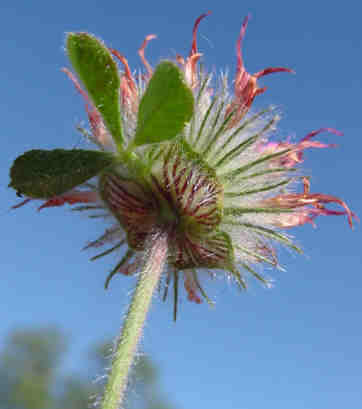 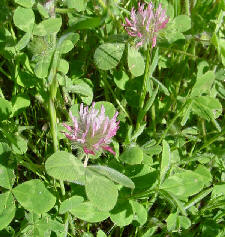 Clover Clover
Family Fabaceae (common Pea)
Trifolium sp.
Perennial,
legume, stems erect, leaves of basal rosette. Leaves are palmately
compound with 3 leaflets. Flowers are 10-15 mm long, rosy purple to
creamy white. Peduncle and calyx are hairy. Can grow on wet or
dry meadows and used as feed for cattle. |
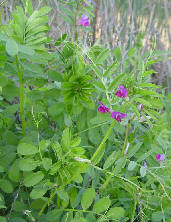 Spring vetch, common vetch Spring vetch, common vetch
Family Fabaceae (common Pea)
Vicia sativa
The leaf is
composed of 4-8 pairs of leaflets. The flower is 10-18 mm long,
with 1-2 flowers at the base of each leaf. Corolla is purple, with
violet on the winds. Tendrils are 2-3 cm long. Compound leaves
have 8-16 opposing leaflets that are 2-3 mm wide. Common during
spring. |
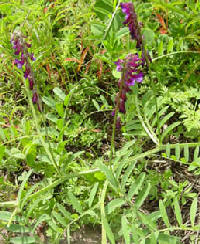 Hairy vetch Hairy vetch
Family Fabaceae
Vicia villosa
Flowers are brightly
colored blue-purples are produced on one side. Leaves are
alternate. Leaves for strong leafy herbage. Drought tolerant. Used
as a crop for cattle throughout the world. Originally from Europe.
|
 Bermuda Buttercup Bermuda Buttercup
Family Oxalidaceae
Oxalis pes-caprae
Small
perennial herb with trifoliate (clover-like) leaves are derived from
an enlarged basal stem tip. Flowers are bright yellow and arranged
in an umbel-like inflorescences with fewer than 20 flowers each.
Yellow petals are less than 2.5 cm in length. Stems have a sour
taste. |
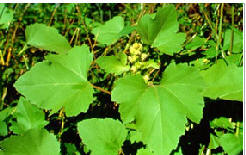 Cocklebur Cocklebur
Family Asteraceae
Xanthium strumarium
Cocklebur is
an annual weed that is common in wetland areas throughout the United
States. The fruit is a hard bur covered with hooked prickles. It
is distributed to new locations by hitching a ride on clothing or
the fur of animals. The bur is said to have inspired the development
of Velcro. |
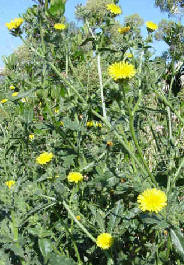 Bristly Ox-tongue Bristly Ox-tongue
Family Asteraceae (sunflower)
Picris echioides
Bristly ox-tongue is a coarse, rough annual plant that grows about 1
meter high. It has stout, erect stems. The alternate leaves are
coarse-toothed to shallowly lobed and have short bristly spines on
the upper surface. The showy yellow flower blooms from June to
December. |
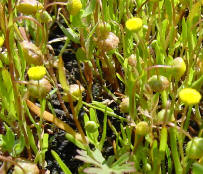 Brass Buttons Brass Buttons
Family Asteraceae (sunflower)
Cotula coronopifolia
Small annual plants with bright yellow
inflorescence that is discoidal in shape. Leaves are not hairy,
irregularly lobed; flower head nearly smooth about 1 cm wide; rays
absent. Found in wet places including margins of salt marshes.
Naturalized from South Africa. |
|
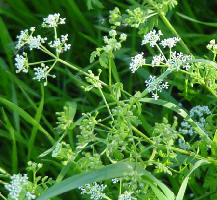 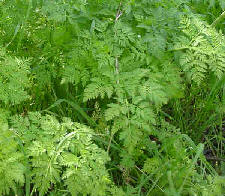 Poison Hemlock Poison Hemlock
Family Apiaceae (parsley)
Conium maculatum
Poison Hemlock is a
perennial herb, 1-2 meters tall. The stems are smooth and hollow
with a characteristic red mottling. Leaves are compound, lacy, and
alternate. The small white flowers borne in compound umbels at the
top of the stalk. The taproot is small and white with a
disagreeable smell. All plant parts are poisonous. The seeds
contain the most poison, a piperidine alkaloid. Socrates is reputed
to have been killed by being forced to drink the juice of this
plant. |
|
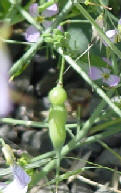 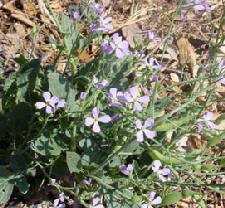 Wild
Radish Wild
Radish
Family Brassicaceae (mustard)
Raphnus sativus
The wild radish belongs to the mustard family.
Flowers can be purple, white, or rose colored petals in the shape of
a “cross.” Long, fat, dark green pods, with noticeable constrictions
in pod between individual seeds. The pods have a peppery taste and
may be added to a salad. |
|
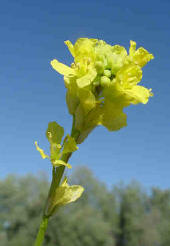 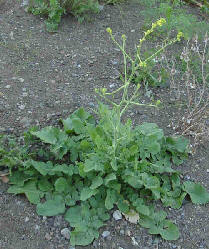 Summer Mustard Summer Mustard
Family Brassicaceae (mustard)
Hirschfeldia incana
Four separate
sepals, four separate petals, six stamens, and a pistil that is
usually partitioned lengthwise. Leaves range in size from 4-10 cm,
densely hairy. Flower is yellow. |
|
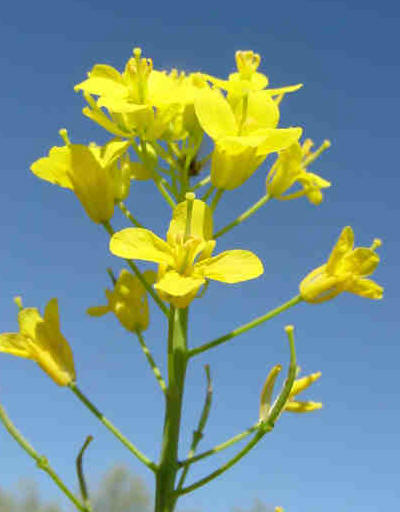  Mustard Mustard
Family Brassicaceae (mustard)
Brassica sp.
Mustards are
winter annuals. All mustard seedlings have broad seed leaves with a
deep notch at the tip. The first true leaves are bright green on the
upper surface and paler below. Mature mustards have dense clusters
of yellow flowers at the tips of branches. Leaves are toothed,
alternate, and are often deeply lobed, especially toward the base of
the plant. Flowers are more abundant than on the summer mustard,
and leaves are not hairy. |
|
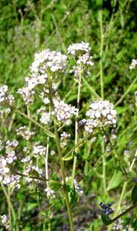 Broad-leaved
Pepperweed Broad-leaved
Pepperweed
Family Brassicaceae (mustard)
Lepidium latifolium
This is an
extremely invasive alien weed that crowds out more desirable native
marsh plants and destroys native wildlife habitat. Perennial
pepperweed is a native of southern Europe and western Asia. The
alternate, waxy leaves have smooth or toothed margins and a
prominent, whitish midvein. Basal leaves are lance-shaped and up to
12 inches long; they are attached by a long stalk that can be almost
as long as the leaf blade. Perennial pepperweed's delicate, milky
white flowers, grow in dense, rounded clusters at branch tips. |
|
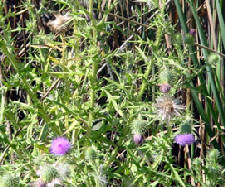 Bull Thistle Bull Thistle
Family Asteraceae (sunflower)
Cirsuim vugare
Bull Thistle has
stiff-hairy stems that can grow as high as 2 meters. It has
conspicuous prickly-winged stems. Flower head has bract-like
leaves below and is purple. It was introduced from Eurasia. |
|
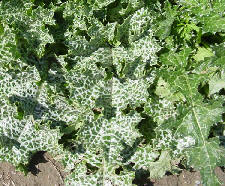 Milk
Thistle Milk
Thistle
Family Asteraceae (sunflower)
Silybum marianus
Stem Is without spines but leaves with many spines. Purple flower
head is up to 5 cm wide with spines. Like other thistles it is best
known for its thorny spines. It can be distinguished from other
thistles by having white veins on the dark green leaves. |
|
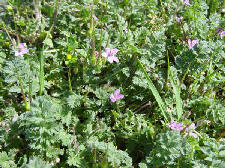 Filaree Filaree
Family Geraniaceae (Geranium)
Erodium cicutarium
Filaree is a
very common, abundant plant of roadsides, fields, and semi-arid
areas often carpeting large areas with bright, tiny, pink flowers.
It produces blooms profusely for many weeks in the spring and
continues blooming into the fall. The leaves and deep roots have a
strong pungent smell. Its long, narrow, pointed heron’s bill-like
seed pods (light green and vertical in the picture) give rise to
the genus name from the Greek , “Erodios,” for “Heron.” |
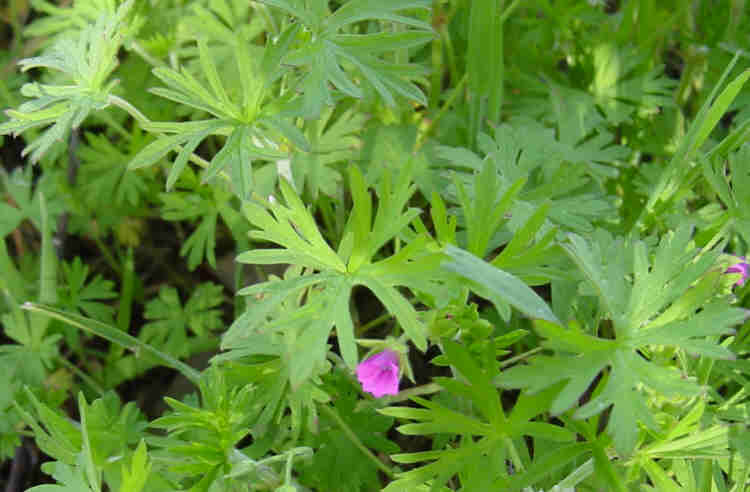 Wild geranium, cut-leaf geranium Wild geranium, cut-leaf geranium
Family Geraniaceae (geranium)
Geranium dissectum.
Stems are short, forked
and hairy. Flowers are a deep rose-purple with 5 petals. The leaf
blades are palmately compound with the leaf margins parted nearly to
the base of the blade. Introduced from Europe. |
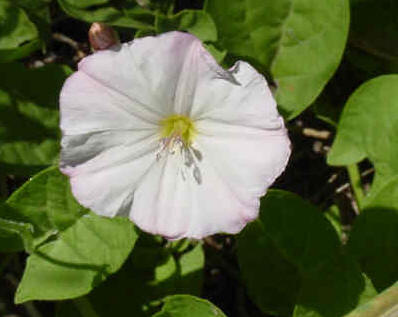 Field bindweed Field bindweed
Family: Convolvulaceae
Convolvulus arvensis
Alternate,
petiolate, variable in shape from ovate to elliptic, to 10cm long.
Blooms from May to September.
Viny
perennial with an extensive system of deep creeping roots and
rhizomes. |
|
 English Plantain English Plantain
Family Plantaginaceae (plantain)
Plantago lanceolata
Characterized by basal leaves (about 45 cm height) and small flowers
concentrated in narrow, dense inflorescences at the stem tip. A
perennial plant with leaves that grow from the rootstock on margined
petioles in a basal rosette. Prefers moist meadows. Tipped by a
short spike of fine white flowers with brownish sepals and bracts
that give the spike its predominantly dark color.
|
|
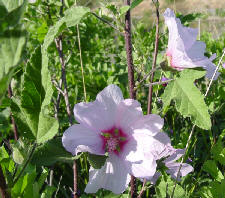 Marsh Mallow Marsh Mallow
Family Malvaceae (mallow)
Althaea cannabina
Perennial
with woody stalks. Flowers have 5 heart shaped petals that are
pink, with a darker pink toward the center of the flower. Height of
plant grows to 2 meters. Leaves are lobed. A similar plant
Althaea officinalis is the original marsh mallow. A.
cannabina’s roots can also be used. The roots were cooked and a
marshmallow type confectionary was made. Marshmallows today are no
longer made this way. |
|
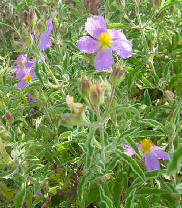 Sage-leaved Cistus Sage-leaved Cistus
Family Cistaceae (Rock Rose)
Cistus salvifolicus
A bushy,
evergreen shrubs that grows in coastal region. Originally from the
Mediterranean. Flowers are borne on long stalks and has 5 petals.
The papery blooms resembles wild rose blossoms. The leaves are pale
to deep green, hairy and with wavy leaf margins. Groups to 30-100
cm. |